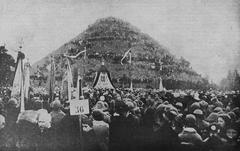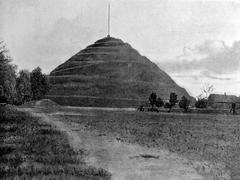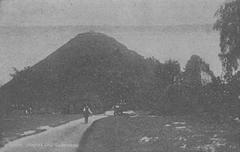
Union of Lublin Mound in Lviv: Visiting Hours, Tickets, and Historical Significance
Date: 14/06/2025
Introduction
Rising atop Lviv’s High Castle Hill, the Union of Lublin Mound (Kopiec Unii Lubelskiej) stands as a powerful testament to a defining moment in Eastern European history: the 1569 Union of Lublin. This artificial mound, constructed between 1869 and the early 20th century, commemorates the 300th anniversary of the union that created the Polish-Lithuanian Commonwealth—a state whose legacy shaped the cultural, political, and social fabric of the region. The mound not only offers panoramic vistas of Lviv and the Carpathians but also serves as a focal point for reflection on the city’s multicultural heritage and the enduring idea of unity.
This guide provides a detailed exploration of the mound’s history and symbolism, along with practical information on visiting hours, tickets, accessibility, and travel tips. Whether you’re a history buff, cultural explorer, or casual traveler, the Union of Lublin Mound presents a unique opportunity to connect with Lviv’s layered past and vibrant present. (agad.gov.pl; Lviv Interactive; Lviv Tourist Information)
Historical Background
The Union of Lublin: Origins and Significance
The Union of Lublin, enacted on July 1, 1569, established the Polish-Lithuanian Commonwealth by formally joining the Kingdom of Poland and the Grand Duchy of Lithuania. This new federative state spanned nearly a million square kilometers, stretching from the Baltic to the Black Sea, and brought together a diverse population of Poles, Lithuanians, Ruthenians, Jews, Armenians, and others. The union emerged from earlier attempts at cooperation, such as the Union of Krewo (1385), and was motivated by dynastic concerns, external threats, and the need for a unified political structure as the Jagiellonian dynasty neared its end (agad.gov.pl).
The Commonwealth became renowned for its unique form of noble democracy, religious tolerance, and intellectual exchange. Cities like Lviv played a central role in its economic and cultural life, fostering a legacy of coexistence and innovation that continues to resonate today.
The Union of Lublin Mound: Construction and Symbolism
Commemoration and Purpose
The Union of Lublin Mound was initiated in 1869 to mark the 300th anniversary of the union, spearheaded by Franciszek Smolka—a prominent Polish liberal politician and activist. The mound’s location atop High Castle Hill, once the site of Lviv’s medieval citadel, underscores its symbolic value as a place of power and memory, reflecting Lviv’s role at the crossroads of Polish, Lithuanian, and Ruthenian histories (agad.gov.pl).
Artistic and Memorial Features
At the summit stands a classicist obelisk—originally erected in 1824—adorned with reliefs representing the union of Poland and Lithuania. The main inscription reads “Joining of Lithuania and the Crown,” encapsulating the spirit of unity. Nearby, Litewski Square references the encampment of Lithuanian nobles during the 1569 negotiations, and other inscriptions throughout Lviv celebrate its shared heritage.
The Mound’s Role in Modern and Historical Memory
During the late 19th and early 20th centuries, especially under Habsburg rule, the mound became a site for Polish patriotic rallies and celebrations of national identity. It also served as a space for Ukrainian national aspirations, particularly after World War I, when Lviv became the focus of competing Polish and Ukrainian claims. Over time, the mound has hosted commemorative events, religious processions, and cultural ceremonies, embodying both conflict and coexistence in the city’s history (Lviv Interactive).
Today, it remains a popular destination for locals and tourists alike, offering a place for contemplation, celebration, and panoramic photography.
Visiting the Union of Lublin Mound: Practical Information
Location and Access
- Address: Vysokyi Zamok St, 7, Lviv, Ukraine
- Altitude: 413 meters above sea level; the mound itself rises an additional 29 meters
- Setting: Located within Vysokyi Zamok Park, featuring terraces, walking paths, and shaded greenery (lia.lvivcenter.org)
Getting There
- On Foot: About a 20–30 minute uphill walk from Rynok Square via Virmenska and Vysokyi Zamok Streets
- By Public Transport: Trams 1 or 9, buses 9, or trolleybus 7 serve the Vysokyi Zamok stop, followed by a short walk uphill
- By Car: Limited parking is available at the park entrance; walking is required for the final ascent (evendo.com)
Visiting Hours and Tickets
- Hours: Open daily from dawn to dusk (typically 6:00 AM to 9:00 PM, varying seasonally)
- Tickets: Free entry; no tickets required
- Note: The park and mound are open year-round; for current details, check Lviv Tourist Information
Accessibility and Facilities
- Paths: Moderately steep paved and gravel paths, with stairs and uneven surfaces near the summit
- Accessibility: Not suitable for wheelchairs or visitors with limited mobility
- Facilities: Benches for rest; no restrooms or food vendors at the summit (facilities are available at the park base or nearby cafes)
- Pets: Dogs are allowed if kept on a leash
Best Times to Visit
- Spring and Summer: Lush greenery and mild weather
- Autumn: Colorful foliage
- Early Morning & Late Afternoon: Ideal for photography and cooler temperatures
- Evenings: Spectacular views of city lights
Activities and Visitor Experience
- Observation Deck: Offers 360-degree panoramic views of Lviv’s skyline and distant Carpathian foothills
- Leisure: Picnics, scenic walks, and occasional cultural events
- Photography: The golden hour before sunset provides optimal light
Safety Tips
- Wear comfortable footwear suitable for uphill walking
- Bring water and snacks, especially during summer or busy periods
- Dress in layers and check weather forecasts (paths can be slippery in winter)
- Keep valuables secure in crowded areas
- Dispose of litter responsibly
Nearby Attractions
- High Castle Park: Shaded trails and relaxing green spaces
- Market Square (Ploshcha Rynok): 15-minute walk; UNESCO World Heritage site
- Lubomirski Palace and Black House: Renaissance architecture and museums nearby
- Lviv Theatre of Opera and Ballet: Historic landmark in the city center
- Lviv Historical Museum: Offers deeper insight into the city’s past
Frequently Asked Questions (FAQ)
Q: What are the visiting hours for the Union of Lublin Mound?
A: Open daily from dawn to dusk (about 6:00 AM–9:00 PM, seasonally adjusted).
Q: Is there an entrance fee?
A: No, the site is free to all visitors.
Q: Are guided tours available?
A: No official tours at the mound, but city walking tours often include it. Audio guides are available via apps.
Q: Is the mound accessible for people with disabilities?
A: The steep paths and steps make access difficult for those with mobility issues.
Q: Are pets allowed?
A: Yes, on a leash.
Q: What should I bring?
A: Comfortable shoes, water, snacks, weather-appropriate clothing, and a camera.
Visuals and Interactive Resources
Final Thoughts
The Union of Lublin Mound is more than a scenic lookout—it’s a living symbol of Lviv’s complex history and the enduring ideals of unity and multicultural coexistence. With free, year-round access and its breathtaking views, it’s a must-visit for anyone exploring Lviv. Prepare for a moderate climb, bring your camera, and consider pairing your visit with other historical sites for a full experience.
For up-to-date information, virtual tours, and visitor tips, consult official tourism sources and local cultural platforms (evendo.com; Lviv Interactive; Lviv Tourist Information).
Useful Resources
- Lviv Tourist Information
- Union of Lublin Mound on Evendo
- Vysokyi Zamok Park Information
- Union of Lublin Mound on Wikipedia
- Union of Lublin Historical Source PDF
- Lviv Interactive—Historic and Cultural Context
- NCCConline Guide to Lviv





































